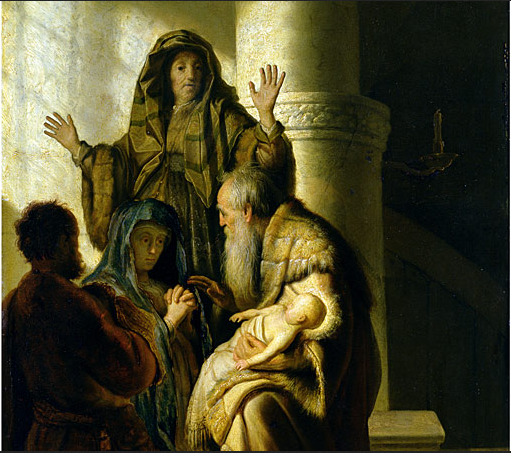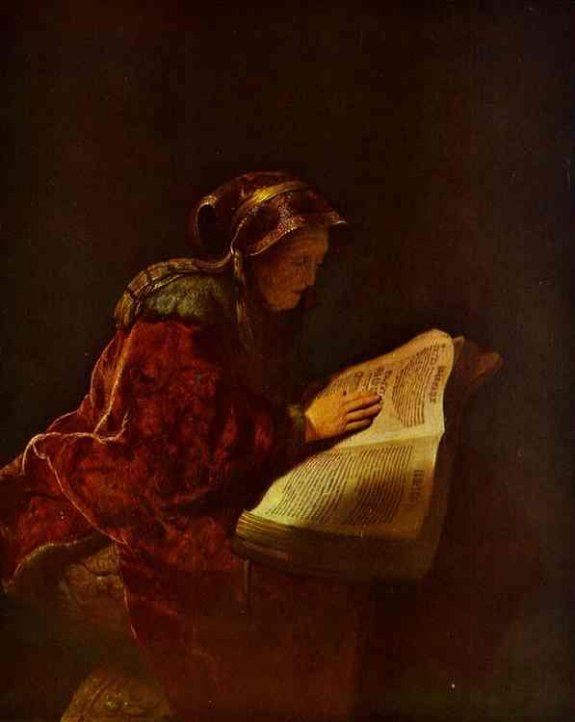Today is Christmas! And Christians around the world will be celebrating it as the birth of Jesus  Christ. Yes, while we know Jesus was most likely not born on December 25th, it is the day designated for the celebration. Growing up Christian, what fascinated me the most wasn’t the birth of Christ (I know, very irreverent of me), but instead, a “prophetess” named Anna. She is probably one of the Bible’s most interesting women, one of the most commonly forgotten, and she remains a great mystery to me.
Christ. Yes, while we know Jesus was most likely not born on December 25th, it is the day designated for the celebration. Growing up Christian, what fascinated me the most wasn’t the birth of Christ (I know, very irreverent of me), but instead, a “prophetess” named Anna. She is probably one of the Bible’s most interesting women, one of the most commonly forgotten, and she remains a great mystery to me.
I know there has been debate as to whether she is a prophet or a psychic, and the differences being that a prophet gets their information from God while psychics get their information for other source (and whose to say it isn’t God giving all the information). Anyway, while that discussion is interesting, we’ll save it for another time. Let’s focus on Anna, as she’s depicted in the Bible.
Anna is introduced at the end of the Birth Narrative (Luke 1:1-2:40) and she arrives at the Temple where the purification of Jesus, Mary, and Joseph is taking place, traditionally 40 days after the birth of the firstborn son. This tradition is based on the written law of the Lord and a sacrifice of a lamb, two pigeons, or two turtledoves is offered as well (Leviticus 12:2-8).
The family is first greeted by Simeon, an old man described as “righteous and devout” who was told by the Holy Spirit that he will not die until he has seen the Messiah. Simeon takes Jesus into his arms, praises God, declares Jesus is God’s salvation and says, ““Master, now you are dismissing your servant in peace, according to your word; for my eyes have seen your salvation, which you have prepared in the presence of all peoples, a light for revelation to the Gentiles, and for glory to your people Israel” (Luke 2:28-32). Simeon is now ready to die. An extra note regarding Simeon, he very well may have been a priest since he held Jesus.
Anna then approaches the family, and Simeon describes her as a “prophetess” (Luke 2:29-32, 34-36). These two individuals arrived separately, but scholars and Christians believe that divine intervention took place on this day.
Luke describes Anna as a woman who is deserving the honor that is bestowed on the elderly in the ancient Mediterranean world.
There was also a prophet, Anna, the daughter of Penuel, of the tribe of Asher. She was very old; she had lived with her husband seven years after her marriage, and then was a widow until she was eighty-four.She never left the temple but worshiped night and day, fasting and praying. Coming up to them at that very moment, she gave thanks to God and spoke about the child to all who were looking forward to the redemption of Jerusalem. – Luke 2:36-38, New International Version (NIV)
Anna is the only female in the Bible described as a prophetess. It’s rather interesting to consider that Luke mentions her tribe (Asher) as well as the name of her father (Phanuel), but not her deceased husband. Also, her dialogue is narrated, where Simeon is directly quoted. Anna is described as someone who never leaves the Temple, she prays and worships night and day by fasting and praying, as well as being available 24/7. It is clear that Anna is depicted as someone who listens to God and is devout. She recognizes the baby immediately and knows who He is. She prays as directed and fasts often, aware that it brings results. She is depicted as being of very advanced age of at least 84 years old.
I’ve always found Anna’s depiction in the Bible very fascinating. She’s a prophetess, but not a psychic, but yet she possesses knowledge that no one else knew and could identify the baby Messiah. And finally, we don’t know much about her, her family, whether she had any children before her husband passed, and her life in the Temple.
Even if you don’t believe in God, or Jesus, or the Bible…it’s worthy to take a glance at Anna and how she is portrayed in a book and religion where consulting psychics was considered as dealing with the Devil.
APS wishes everyone a blessed holiday celebration!



Why was Ana considered a prophet versus a soothsayer? The answer to that question lies in the authorship of the Gospel of Luke & Acts. In the past it was widely accepted that both were written by Luke the companion of Paul (Colossians 4:14). Many modern theological scholars now argue that fact, and believe multiple authors were involved. In either case the truth remains the same- 1 Corinthians 12 the application Spiritual Gifts. Ana would have had to have Ministry Gifts: Prophet, A prophet functions as God’s voice, speaking forth God’s Wisdom. The witnesses or author would have had the gifts of Revelation:Discerning of Spirits – This is the supernatural ability to distinguish between spirits such as good and evil, truthful or deceiving, prophetic versus satanic.Based on Ana’s worship regiment, and the fact she was a Sainted by the Catholic Church the gift of Power:Faith, supernatural faith given by the Spirit to receive miracles or to believe God for miracles. Three gifts, the trinity at at work, or the use three, is a common trend throughout the Holy Bible authorship.
Why was Ana considered a prophet versus a soothsayer? The answer to that question lies in the authorship of the Gospel of Luke & Acts. In the past it was widely accepted that both were written by Luke the companion of Paul (Colossians 4:14). Many modern theological scholars now argue that fact, and believe multiple authors were involved. In either case the truth remains the same- 1 Corinthians 12 the application Spiritual Gifts. Ana would have had to have Ministry Gifts: Prophet, A prophet functions as God’s voice, speaking forth God’s Wisdom. The witnesses or author would have had the gifts of Revelation:Discerning of Spirits – This is the supernatural ability to distinguish between spirits such as good and evil, truthful or deceiving, prophetic versus satanic.Based on Ana’s worship regiment, and the fact she was a Sainted by the Catholic Church the gift of Power:Faith, supernatural faith given by the Spirit to receive miracles or to believe God for miracles. Three gifts, the trinity at at work, or the use three, is a common trend throughout the Holy Bible authorship.